- An Unparalleled Ecosystem
- Ecosystem Services of Coral Reefs
- The Coral Crisis
- What’s driving their destruction?
- Coral Bleaching - the canary in the coral mine
- Coral Reef Restoration - a tool in the box
- Our Project Area
- The Restoration Approach
- Local Team & Community Involvement
- A closer look at coral
- Project FAQs
- Coral Attachment Experiment | VLOG
- Restoration Deployments | VLOG
- Project Discussion
- Management Plan
- Total budget: £147,200
- Budget spent: £80,698
- Status: In Progress
Coral reefs are known as “the rainforests of the sea”. These vibrantly complex ecosystems harbour the highest biodiversity of any ecosystem globally. An estimated 25% of all marine species depend on reefs. They are also crucial for millions of people, providing food, livelihoods, resources and coastal protection.
Major threats, such as over-exploitation and climate change, are jeopardising the future of coral reefs. In the last few decades, sharp declines in reef cover have occurred worldwide. This is our first coral reef project to restore damaged reefs in the northern waters of Nusa Penida, Indonesia.
Our long-term goal is to improve resilience by enhancing connectivity of fragmented reefs whilst protecting and preserving endangered coral species. Led by our local team of expert divers and marine biologists passionate about the preservation of this marine ecosystem, we work with local people to promote positive community involvement in coral reef restoration.
Project Timeline
June 2024 - December 2025
Install 5,000 reef restoration structures with transplanted coral and carry out maintenance to prevent algae outcompeting new coral fragments. During these maintenance visits, we will take measurements of coral health and growth rates.
read moreSeptember 2023
Site preparation and surveys: Generating a 3D map of each rubble area within our project site, which spans approximately 1,200 square metres and is located at a depth of 4-8 metres.
An Unparalleled Ecosystem
Coral reef ecosystems support the highest biodiversity of any ecosystem globally. To many that have experienced the captivating world of coral reefs, their beauty and biodiversity is unparalleled. These underwater realms offer a sensory explosion of colours, textures and life.
Within this complex and intricate ecosystem, interdependent communities of organisms and animals thrive. A dazzling array of diversity lives in the 3-dimensional labyrinths of coral reefs, where all kinds of creatures seek shelter in its nooks and crannies. Countless types of algae, sponges, marine worms, echinoderms, molluscs, crustaceans, fish and of course, corals inhibit reefs.
Considered the backbone of the ecosystem, coral species come in all shapes, sizes and colours. Ranging from the delicate, branching structures of staghorn corals to the huge, brain-like formations of massive corals. Up to 750 species could exist on one coral reef alone!
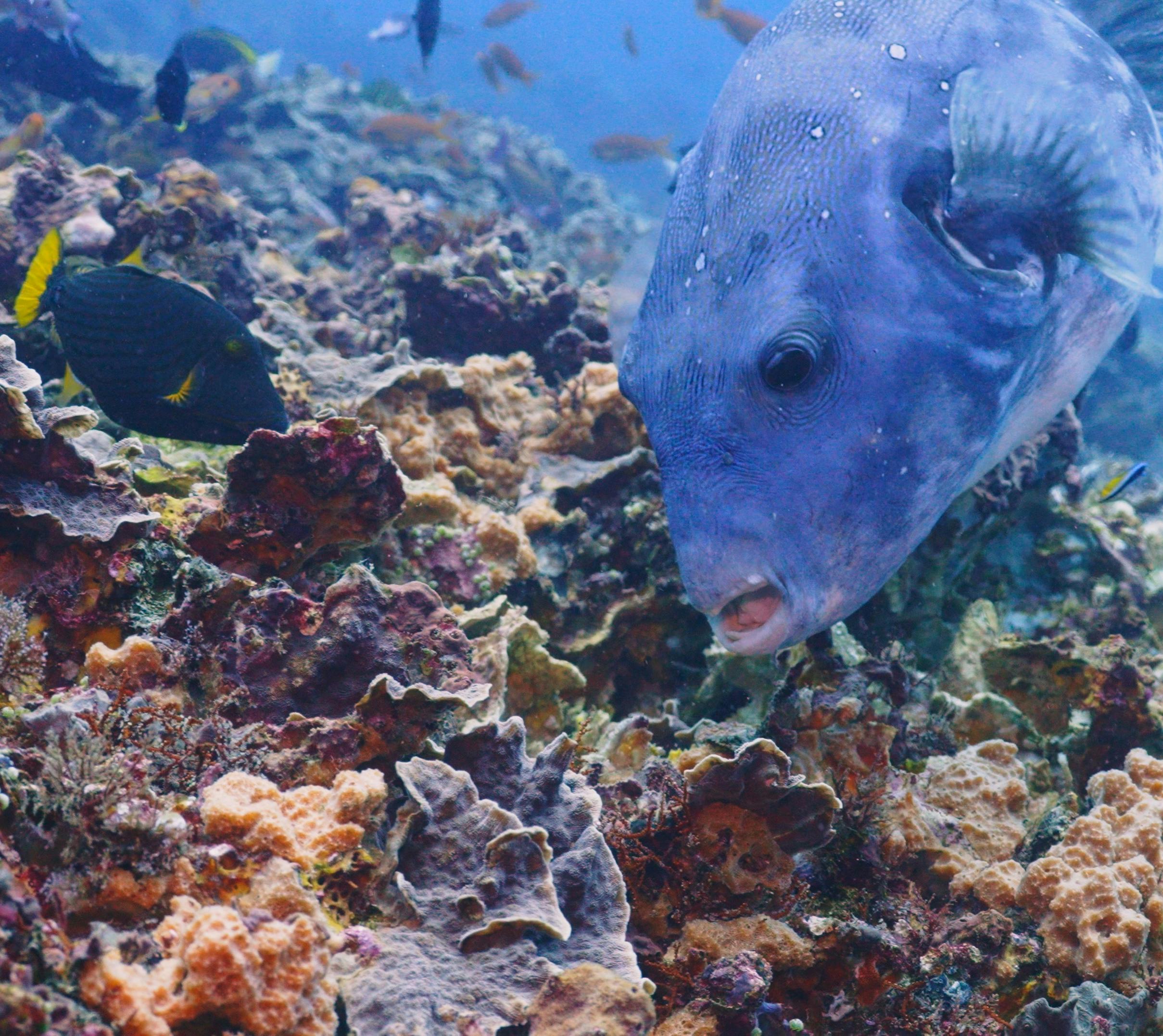
Ecosystem Services of Coral Reefs
Beyond their aesthetic and ecological value, coral reefs also serve other vital purposes. An estimated 30 million of the world’s poorest people depend entirely on coral reefs to provide food. Worldwide, an even greater 500 million people rely on coral reefs directly or indirectly for livelihoods, food and other resources.
Acting as a physical barrier, coral reefs are a natural defence for coastlines from tidal surges, extreme weather events, ocean currents, and winds. This prevents coastal erosion, flooding and a loss of infrastructure, which equates to significant cost reductions in damage to coastlines and displacement of communities. It’s estimated the potential annual benefit is 314 million USD for coastal protection in Indonesia.
Coral reefs are also a key part of land accretion. During this natural process, pounding waves break down pieces of calcified coral that wash up and add layer upon layer to beaches.
In terms of culture, coral reefs hold significant intrinsic and recreational value. They are easily accessible playgrounds and main attractions for tourists, divers, snorkelers and recreational fishing.
Coral also contributes to blue carbon (CO2 stored in the ocean) when corals combine with other coastal ecosystems, such as mangroves and seagrass, and plays a role in carbon cycling in reefs (CaCO3).
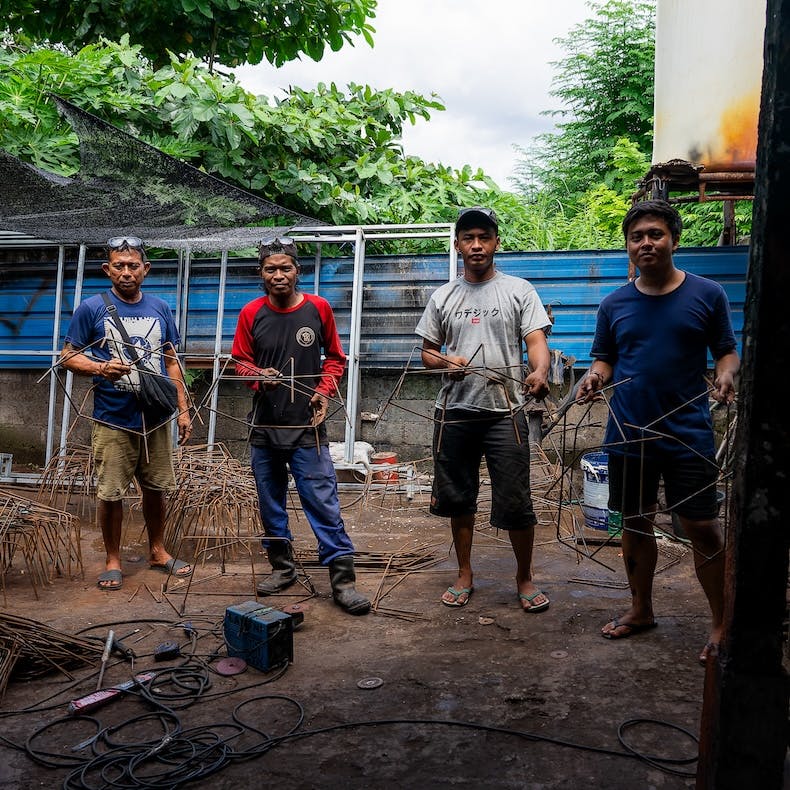
The Coral Crisis
Given some coral reefs take millions of years to form, the current rate of their destruction is a major concern for the health of our planet. There are estimates that a frightening 50% of coral reefs have been lost in the last 30 years.The IUCN Red List Index of species survival 1980-2012, states their decline during this period has been faster than birds, mammals and amphibians.
Projections from the IPCC reports (2018) warn of further bleak scenarios. According to some climate models, even with the Paris Agreement target of a 1.5℃ increase in global warming, subsequent bleaching events could lead to 90% of all coral reefs disappearing.

What’s driving their destruction?
The major threats facing coral reefs around the world include:
- Global Warming and Climate Change: Greenhouse gas emissions have led to increases in global surface temperatures, consequently causing unprecedented mass coral bleaching events.
- Overexploitation (overfishing): The global demand for fish has doubled in the last 50 years. It’s been calculated that the Indonesian archipelago provided 60% of the live fish food trade during the 1990s. Coral reefs are vulnerable to this effect due to being easily accessible by small boats.
- Destructive fishing: Despite now being illegal in South and Southeast Asia, severe damage has been done through practices such as purse seining, fine-mesh fishing, ‘moxy’ nets, cyanide fishing and blast fishing. Over half of Indonesia’s coral reefs have been threatened by destructive fishing activities.
- Sediment, chemical and nutrient pollution: Human developments, such as the construction of resorts, ports and urban areas, can greatly impact coral reefs from increased water runoff as excessive amounts of sediment are deposited into the ocean. This erosion transports particulate matter, sewage, or dangerous levels of nutrients from agricultural activities. All this can lead to coral reefs being smothered and triggering eutrophication, where toxic algal blooms and decreased oxygen levels severely affect life on the reef.
- Other threats and disturbances include: natural disasters and extreme weather events, predator outbreaks, invasive species, irresponsible tourism, coral mining and harmful trades such as the aquarium industry and trinket trade.
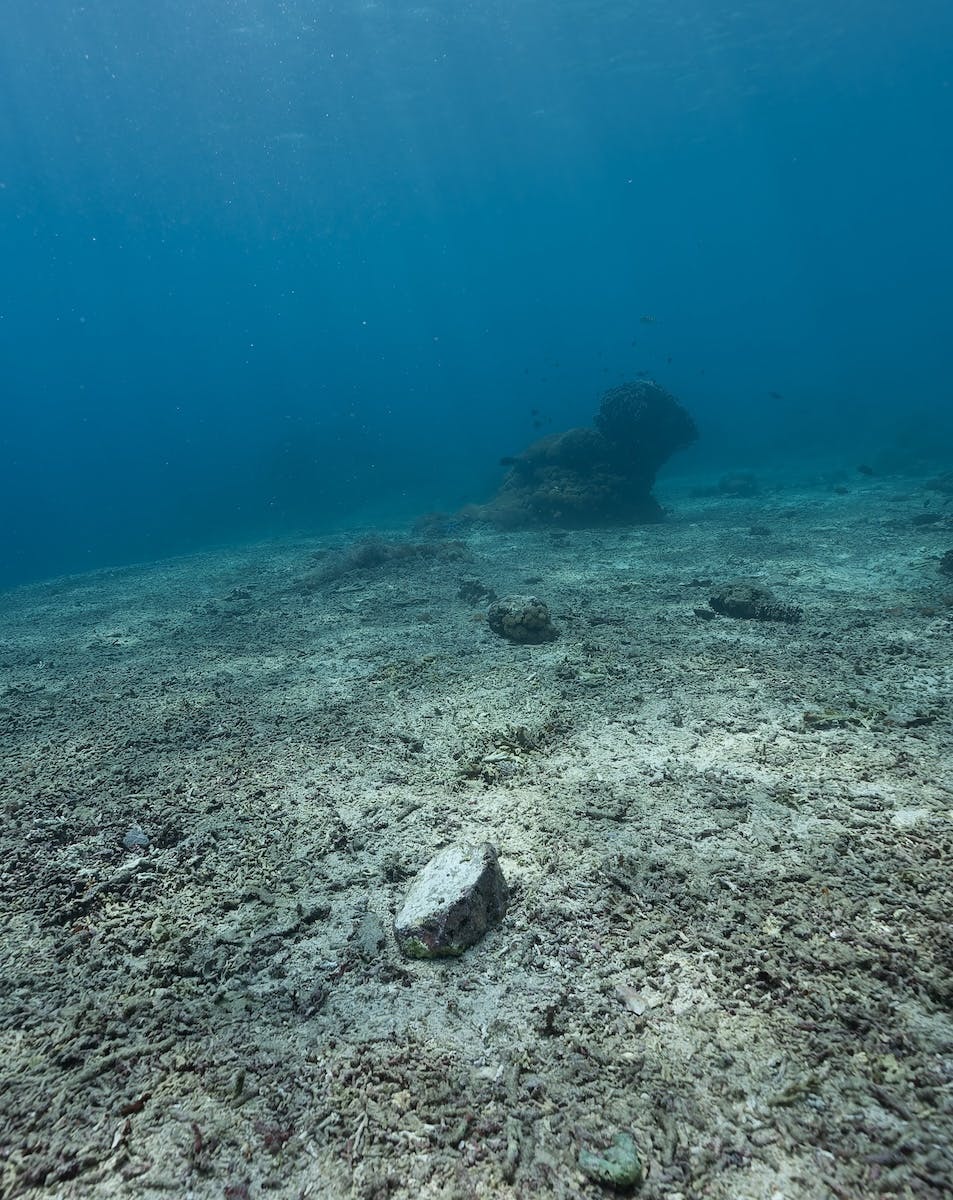
Coral Bleaching - the canary in the coral mine
Coral bleaching occurs when there is a breakdown in the mutualistic relationship between zooxanthellae and coral polyps (learn more below). The algal cells respond to high water temperatures by producing an irritant instead of food. This causes the polyp to stress and expel their food-producing algal cells. The ‘white’ bleaching effect is due to the loss of zooxanthellae.
Bleaching happens when water temperature increases of 1–2°C are sustained for several weeks. These are referred to as the ‘canary in the coral mine’ situations that serve as an early indication of coral sensitivity to lethal conditions. Prolonged bleaching results in the tragic large-scale die-off of coral in mass bleaching events.

Coral Reef Restoration - a tool in the box
Critics argue coral reef restoration methods do not address the main issue affecting reef declines - climate change and the resulting warming of our oceans. Although restoration methods are not intended to impact the climate, they serve as a useful tool in the box needed to sustain reefs amidst increasing pressures. Rather than being a silver bullet, they are designed to build reef resilience by maintaining or repairing key ecosystem processes, functions and services. Restoration is particularly important for local contexts where natural coral recolonisation is limited and threats can be mitigated.
To give coral reefs the best possible chance of surviving into the future, action needs to be taken on multiple fronts. It is important to vigorously pursue climate action, a reduction in anthropogenic pressures and effective coral reef restoration in conjunction.

Our Project Area
Pura Mas Gading, Nusa Penida
Our restoration site falls within the Nusa Penida Marine Protected Area (MPA) at a dive site locally known as Pura Mas Gading. It is located in the North of Nusa Penida around a hundred metres off the coast at Sental Kangin Beach, Ped Village. It is well known for its longshore currents, providing a nice drift dive for scuba divers.
Destruction of the reef
Although the MPA was established in 2010 with strict monitoring of tourism and fisheries zones, unfortunately this hasn't always been the case. The areas of reef we are targeting have been degraded to a state of coral rubble from overexploitation, predominantly from dynamite fishing. When coral rubble accumulates, it becomes a coral rubble field which is constantly shifting in the currents and swells.
This movement of loose rubble will damage, dislodge and smother any young coral polyps that try to establish within this area, preventing natural regeneration of damaged reefs from occurring.
The current state of the coral at Pura Mas demands what’s referred to as ‘emergency restoration’ to repair ecosystem functionality in the UN’s guide ‘Coral reef restoration as a strategy to improve ecosystem services’.
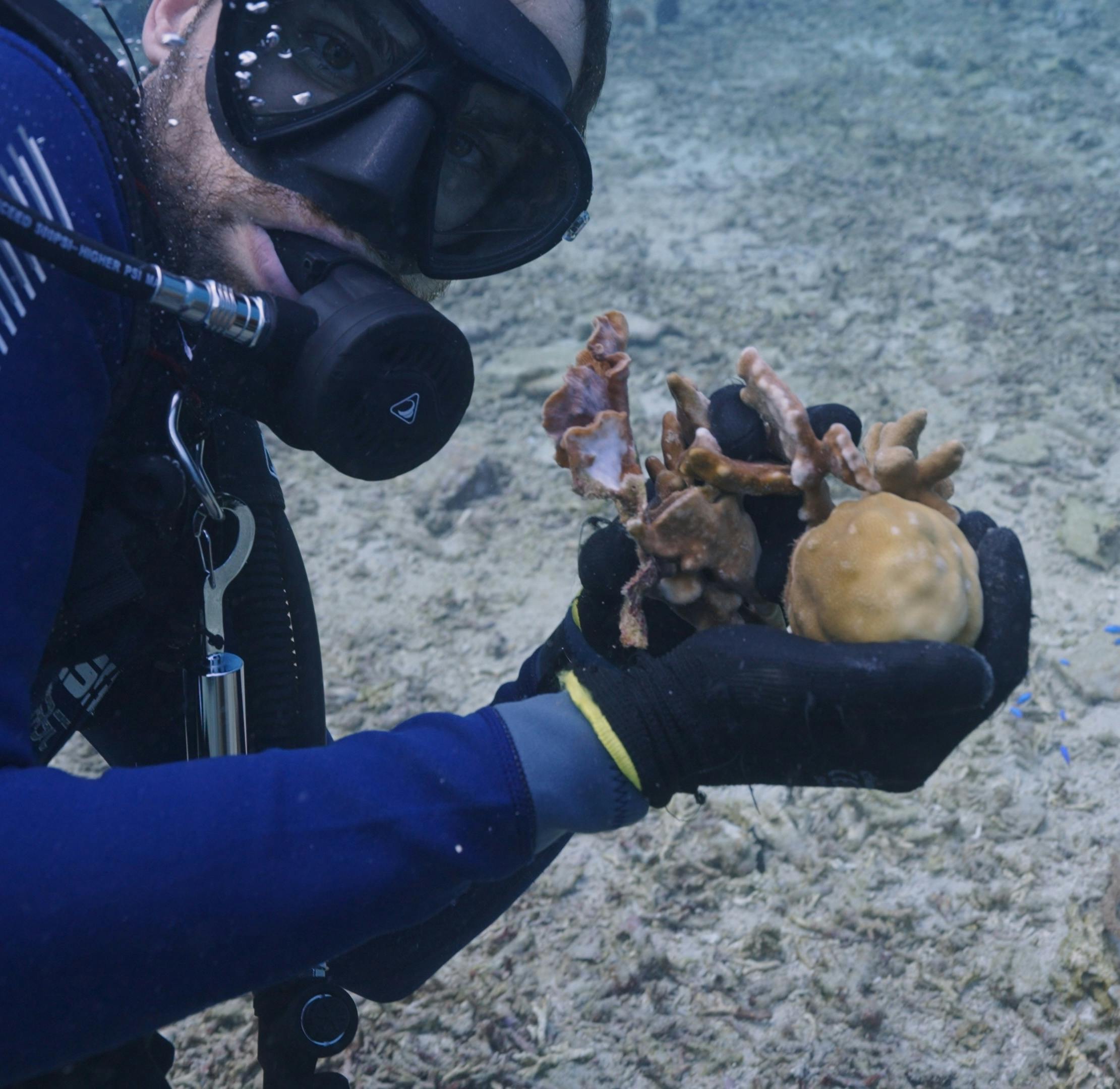
The Restoration Approach
The overarching aim of this restoration activity is to restore the live coral substrate within 0.9 ha of the Mas Gading Temple area in the northern waters of Nusa Penida.
The first stage is to stabilise the coral substrate so it can’t damage young coral and kickstart natural regeneration. The rubble areas we are prioritising are full of debris with some areas of algae, which is preventing the neighbouring healthy coral from spilling over and naturally colonising the area.
How we aim to restart the recolonisation process:
- To stabilise the substrate and encourage recolonisation, we will produce and install around 5,000 artificial reef restoration structures within rubble areas between 2024-2025. These metal hexagonal structures (inspired by MARS Reef Stars) are secured to the seabed using stakes. Around 50 cm in diameter, they tessellate together to form something akin to a very large net to hold down the loose rubble. Before the structures enter the water, we coat them in resin and sand to protect against erosion and promote coral attachment.
- To create source populations of corals within the rubble areas, we will attach 12-15 transplanted coral fragments onto each restoration structure. The coral fragments are loose pieces of coral that have naturally dislodged from a substrate due to environmental conditions, such as strong currents as well as the action of corallivores (animals that feed on coral), like parrotfish. Our team collect a range of coral fragments to ensure a suitable level of species diversity within the area that would mimic the natural colonisation of a new reef.
- To reduce macro-algae locally to the reef structures and facilitate coral growth and establishment, we will regularly monitor the structures. This is to not only brush off any algae smothering our coral fragments, but also to visually inspect the health of the fragments, checking for calcium carbonate deposition. Stressed corals will deposit little calcium carbonate, whereas thriving corals will be actively expanding their corallite skeleton.
Coral Species
These are some of the species we have transplanted at Pura Mas:
Acropora, Montipora, Symphyllia, Seriatopora, Stylophora, Caulastrea, Fungia, Montastraea, Porites, Turbinaria, Echinopora, Platigyra and Goniopora

Giving 'coral of opportunity' a second life
Here is the process of coating reef restoration structures; securing coral rubble areas; collecting coral fragments; and attaching transplanted coral to structures (Nusa Pendida, May 2024).
Local Team & Community Involvement
Our local Indonesian team managing and implementing this project are Yudi and Chansa, an expert diver and marine biologist, who were concerned about the condition of coral reefs in Indonesia damaged by pollution, illegal fishing and climate change and felt compelled to act. With their passion and commitment, they lead our efforts in protecting and restoring the coral reef of Pura Mas and all its incredible biodiversity.
Key to achieving this goal, we contract local divers, boat captains, and local community members to construct and deploy the restoration structures and have established the Pelestarian Laut Nusantara Foundation, a non-profit organisation registered by Mossy Earth in Indonesia, with the following in mind:
Vision
Maintaining the preservation of coral reefs and marine biodiversity through conservation & research, education and empowerment of local communities.
Mission:
- Carry out advocacy and education to the community, government and other stakeholders about the importance of coral reef conservation.
- Conduct research and development of science and technology related to coral reefs and marine resources.
- Carry out rehabilitation and restoration of coral reefs damaged by climate change, pollution and over-exploitation.
- Encourage participation and empowerment of coastal communities in sustainable and ecosystem-based management of coral reefs.
- Build a collaborative network with various parties who have the same vision and mission in the field of coral reef conservation.
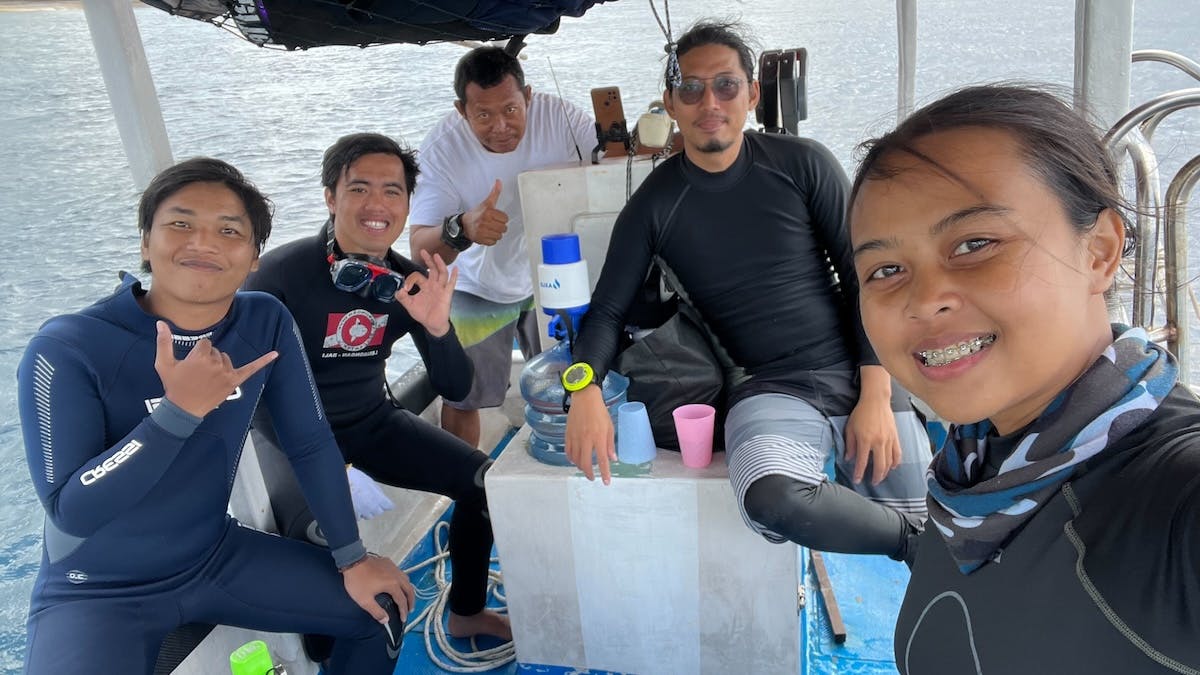
My passion for the ocean is the driving force behind my involvement in the coral restoration project. The ocean's vastness and mystery have always captivated me, and the opportunity to actively engage in its preservation is incredibly rewarding for myself. This project allows me to give back, to protect and nurture the marine life that fills me with wonder.
Chansa Hilmira, Marine Biologist @ Mossy Earth
A closer look at coral
Coral appears like solid rock or bone but is, in actual fact, a living animal. Zoom in and you will see tiny anemone-like animals called polyps swaying like flowers in the water. These minute marine invertebrates have a soft, tubular body with a mouth surrounded by a ring of tentacles on top. Inside each polyp is a gut lining of tissue threads that help coral digest food. Tiny plant cells called Zooxanthellae live in the coral gut and provide them with their colourful compounds. Clustering together in colonies, coral share their food in a connected network.
There are two main types of coral - stony/hard and soft corals.
Hard corals include an impressive range of structural shapes from the spiral-like foliaceous, finger shaped digitate to the tabular and mushroom forms. Shallow water hard corals have a mutualistic association zooxanthellae. These single-celled organisms (coral can host a million cells in 1 cm2) harness the sun’s energy to photosynthesise and produce food. Zooxanthellae generously give around 90% of their own food to coral polyps, which are organic products of photosynthesis including glucose, glycerol and amino acids. In exchange, the algal cells receive nutrients and protection against herbivores and currents.
These are known as hermatypic corals that also secrete a hard, calcium carbonate skeleton. The skeleton provides anchorage for the polyp, acts as a hideaway from danger, and is the substance that forms reefs. When billions of polyps fuse their calcium carbonate structures, coral reefs are born. Known as a 'foundation species', coral is the base that supports these bustling underwater metropolis.

Rainforests of the Sea
The colourful underwater world of coral reefs lures marine species of all kinds. This is a small fraction of the species found in Nusa Penida's waters.
Project FAQs
- Can you cover the differences between growing coral fragments and spawning corals? Is the increased difficulty of spawning corals worth it?
Coral fragments are known as ‘corals of opportunity’ within the restoration world. This refers to the fact that they have already broken off their main structure (from disturbances such as storms or anchor damage) and will die unless they find a solid substrate to attach to.
Coral spawning (or larval-based coral propagation) involves inducing coral to spawn in an artificial environment or collecting spawn directly from the ocean (this is very challenging!) and rearing larvae in the lab. Once you have successfully reared the larvae, they can either be released to settle directly on the reef or encouraged to settle on an artificial substrate in the lab to be out-planted to the ocean at a later date.
In terms of genetic viability, coral spawn will be more genetically diverse than using clonal fragments. For our project, we aren’t actively propagating coral spawn to attach to the structures because the surrounding reef will do that for us (and will have much greater success!).
The adjacent healthy reef is already spawning into our rubble areas but the loose rubble is dislodging and burying the young spawn. By deploying restoration structures, we will hold down the rubble and allow these coral spawn to survive. We hope some of them will choose
to attach to our restoration structures themselves!
Researching Coral Attachment
- Are there alternatives to plastic cable ties for securing the coral fragments to the structures?
Based on the evidence found in current literature, cable ties provide the most secure attachment for transplanted coral fragments and therefore are the default attachment method for coral reef restoration. Cable ties are easy to use, form a secure attachment under water and won’t degrade before the coral has had time to form its own attachment to the substrate. In the process of coral attaching to the structures, a coralline algae would first cover the ties. The plastic surface would be covered in a few weeks, then the coral itself would layer over it. Based on some research, coralline algae contributes significantly to reef cementation, helping coral to encrust.
Alternatives like wire can be prone to rusting and snapping before the corals have formed their attachment while biodegradable alternatives to cable ties and natural ropes are difficult to form a tight attachment underwater and often biodegrade before the coral has attached to the substrate.
On the one hand, we always do our best to follow evidence-based best practice but on the other hand we just can’t shake the juxtaposition of adding plastic into our oceans while trying to restore them. Existing studies are interested in the universal applicability of these methods for widespread use. However, we would like to run our own version of these experiments to learn whether our experienced team of divers and marine biologists can overcome these usual pitfalls to plastic alternatives with a bit of extra patience and time. To find a plastic free alternative to cable ties that doesn’t compromise coral survival would be a game changer in facilitating plastic free coral reef restoration.
To test this, we will be comparing the cable tie to 3 biodegradable alternatives. To assess the effectiveness of each attachment method, we will monitor each fragment every week for three months and assess coral self attachment (defined by the growth of new tissue across the substrate from more than two thirds of the coral fragment), coral detachment (where the coral fragment is lost from the structure) and mortality rates (where the fragment is still attached but is showing significant disease or stress induced bleaching).
Coral Attachment Experiment | VLOG
See the initial results of our trial.
Restoration Deployments | VLOG
Go underwater with our team to see the deployment of transplanted coral in action.
Project Discussion
Our Project Manager Yudi explains how this project evolved and breaks down the restoration process in-depth.
the team behind the project

Purnomo Yudhianto Project Manager @ Mossy Earth
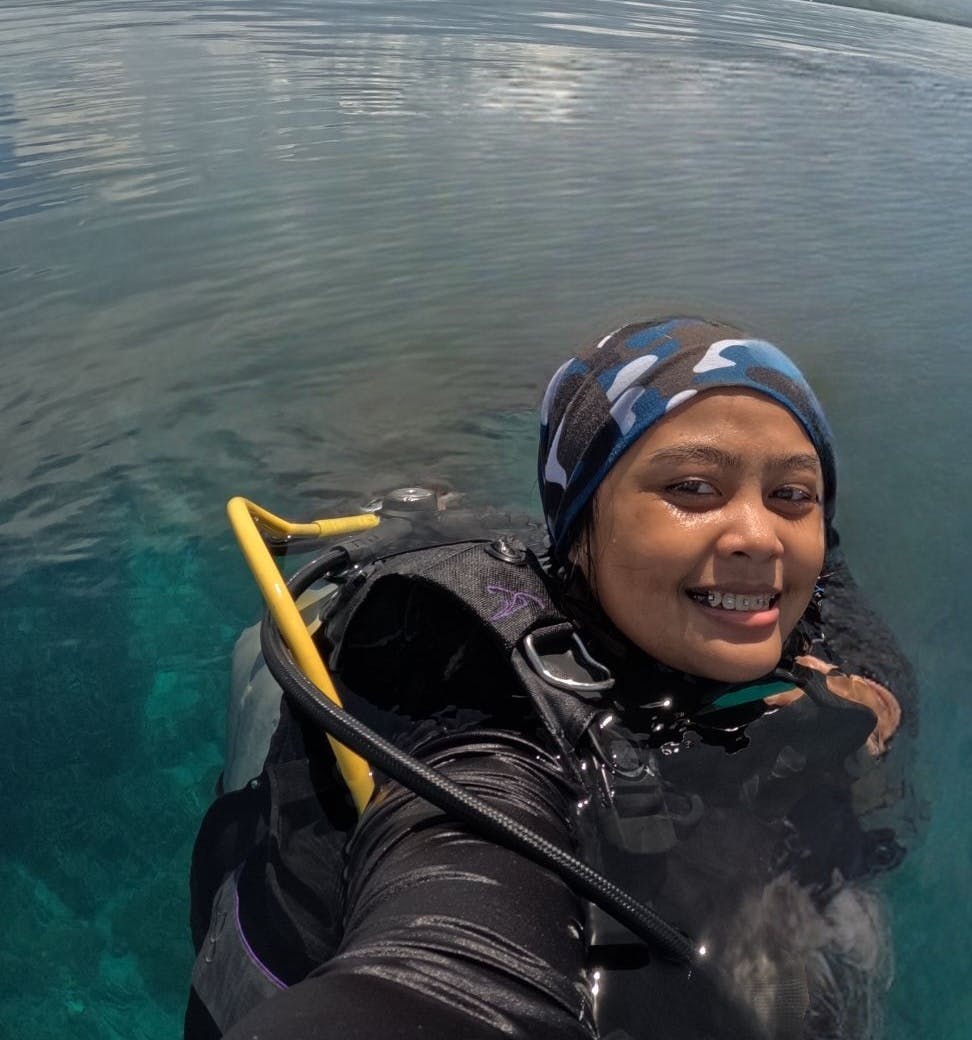
Chansa Hilmira Marine Biologist @ Mossy Earth
Sources & further reading

- “Coral reef restoration as a strategy to improve ecosystem services. A guide to coral restoration methods. United Nations Environment Program, Nairobi, Kenya.” - Boström-Einarsson et al. 2020.
- “Status of Coral Reefs of the World: 2020” - Global Coral Reef Monitoring Network (GCRMN), International Coral Reef Initiative (ICRI)



















